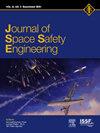Benefits of using functional safety in commercial space applications
IF 1.7
Q3 ENGINEERING, AEROSPACE
引用次数: 0
Abstract
According to IEC61508 functional safety is relevant whenever a product or system contains electrical, electronic or programmable electronic elements that perform safety-critical functions. It is used in many areas of technology such as, process industry (e.g., energy sector), automotive (transport sector), mechanical engineering, or aviation. This article will compare the approaches and concepts of Functional Safety based on IEC61508 and ISO26262 with the RAMS (Reliability, availability, maintainability and safety) approaches of the space industry, in particular with the Fault Detection Isolation and Recovery (FDIR) approach.
The paper will provide an insight into the possibilities of minimizing risk at the component level, especially for complex integrated circuits. Traditionally, the space industry has focused on qualifying the components used for the extreme environmental parameters and the typically very long duration of use in space. However, as ICs (Integrated Circuit) have become very complex, there is significantly increased risk of systematic failures that can occur during the development of the component itself and also by the designer using it for development the actual circuit board assembly.
In addition, the cost of components is a major factor in the development of satellite constellations due to higher volumes, so a trade-off between qualification and affordability must be found.
The presentation will show how systematic faults in other market sectors can be avoided as far as possible and how so-called random faults can be detected as quickly as possible and their effects ideally eliminated or at least minimized with the help of appropriate performance features of the semiconductor products, such as ECC (Error Correction Code), lock-step, or BIST (Built-in Self Test).
The successful mission of the Mars Rotorcraft Ingenuity from JPL (NASA) provides an insight into the practical application of a functional safety concept in a space application.
This paper is intended as a suggestion on how to make the best use of existing features of semiconductor products developed for functional safety in other market sectors also for space applications.
在商业空间应用中使用功能安全的好处
根据IEC61508,只要产品或系统包含执行安全关键功能的电气,电子或可编程电子元件,功能安全就是相关的。它被用于许多技术领域,如过程工业(例如,能源部门),汽车(运输部门),机械工程或航空。本文将比较基于IEC61508和ISO26262的功能安全方法和概念与航天工业的RAMS(可靠性、可用性、可维护性和安全性)方法,特别是故障检测、隔离和恢复(FDIR)方法。本文将提供一个洞察到最小化风险的可能性在组件水平,特别是复杂的集成电路。传统上,航天工业的重点是使所使用的部件符合极端环境参数和通常在太空中使用很长时间的要求。然而,由于ic(集成电路)已经变得非常复杂,在组件本身的开发过程中以及设计人员使用它来开发实际电路板组件期间可能发生的系统故障风险显着增加。此外,由于体积较大,组件的成本是卫星星座发展的一个主要因素,因此必须在合格和可负担性之间找到权衡。该演讲将展示如何尽可能避免其他市场领域的系统故障,以及如何尽可能快地检测到所谓的随机故障,并在半导体产品的适当性能特征的帮助下,理想地消除或至少最小化其影响,例如ECC(错误纠正码),锁定步骤或BIST(内置自检)。来自JPL (NASA)的火星旋翼飞行器独创性的成功任务提供了对功能安全概念在空间应用中的实际应用的深入了解。本文旨在就如何在其他市场部门以及空间应用中充分利用为功能安全开发的半导体产品的现有特性提出建议。
本文章由计算机程序翻译,如有差异,请以英文原文为准。
求助全文
约1分钟内获得全文
求助全文
来源期刊

Journal of Space Safety Engineering
Engineering-Safety, Risk, Reliability and Quality
CiteScore
2.50
自引率
0.00%
发文量
80
 求助内容:
求助内容: 应助结果提醒方式:
应助结果提醒方式:


